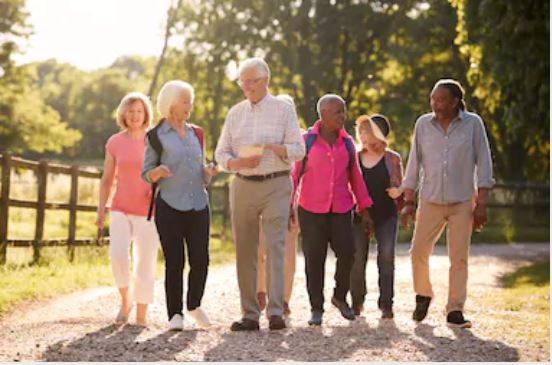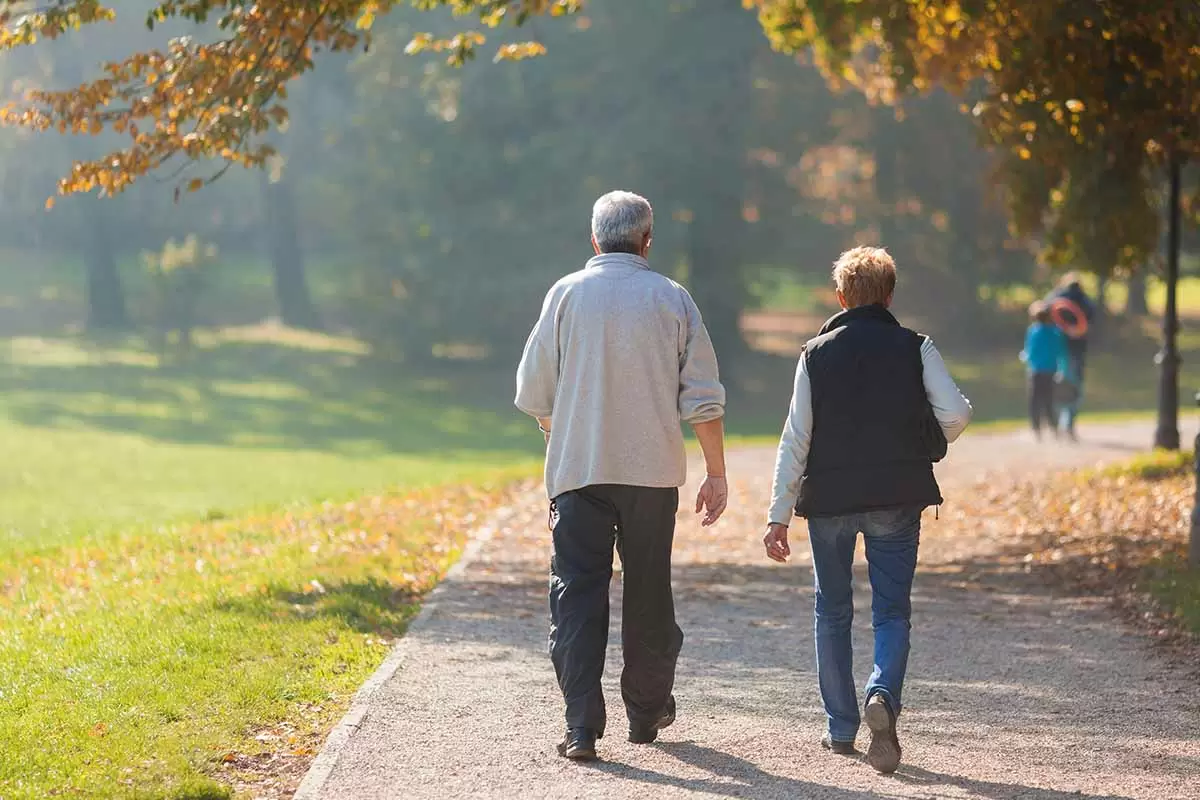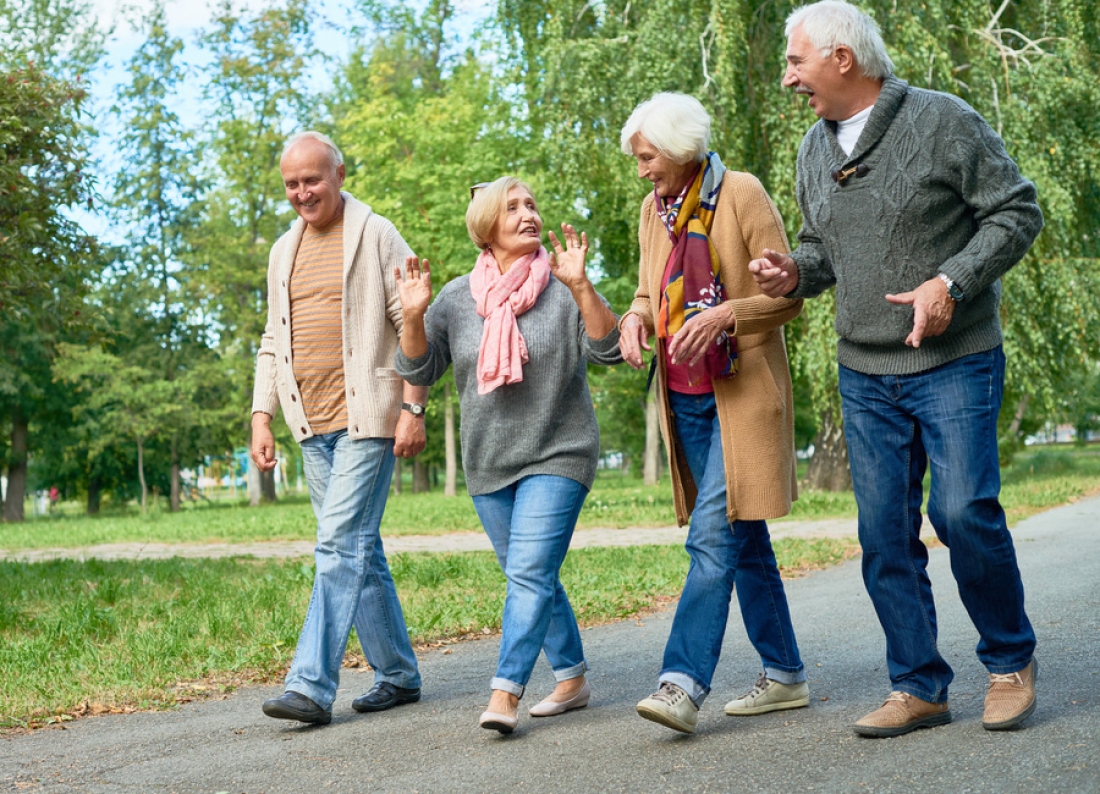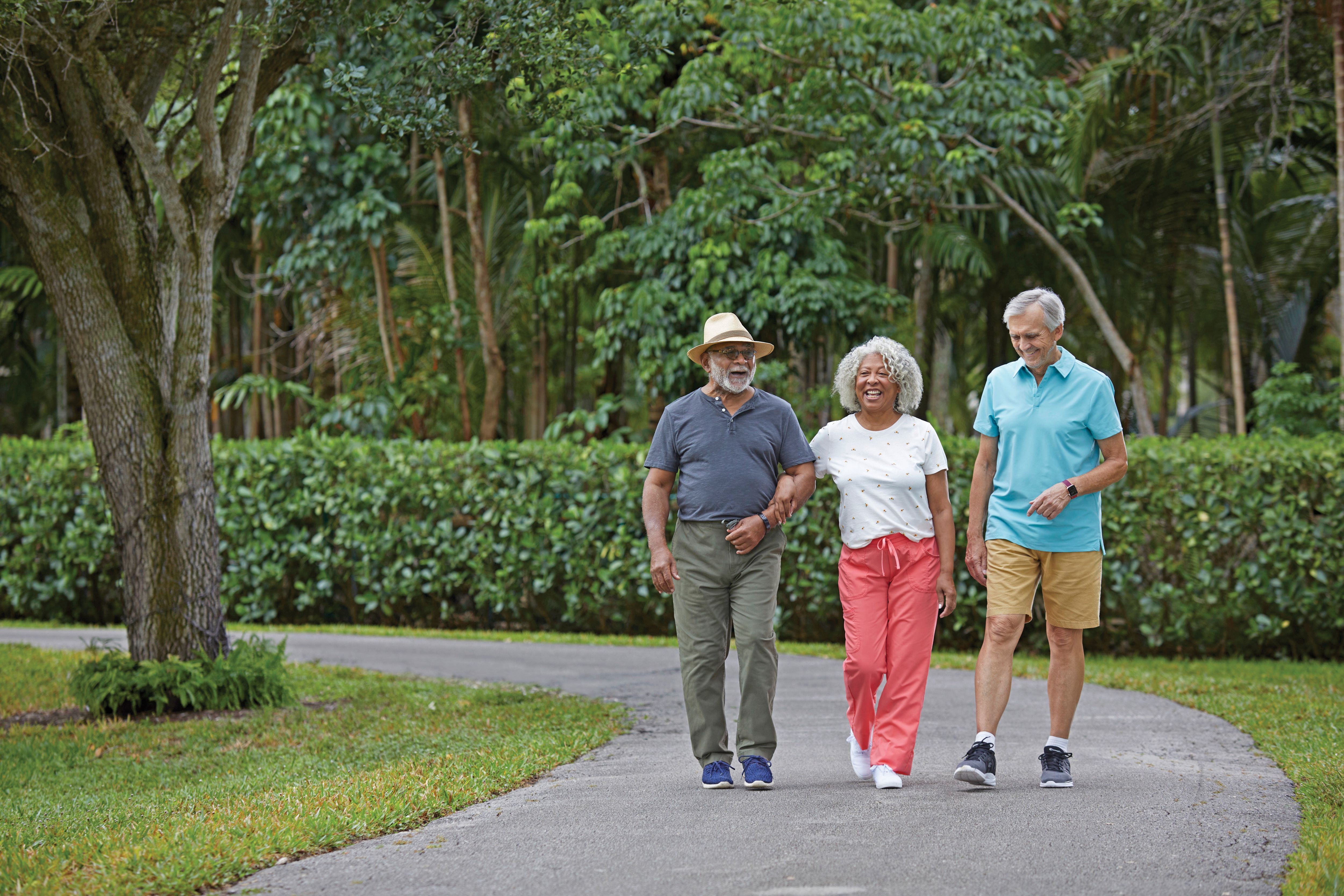
For older adults, the question isn’t just “how far?” but “how consistently and safely?” While general health guidelines exist, the “ideal” walking distance—in kilometers or miles—is highly individual, depending on a person’s current fitness level, health conditions, and mobility.
🎯 The Baseline Recommendation: Steps vs. Distance
Instead of a rigid kilometer target, most major health organizations, like the U.S. Centers for Disease Control and Prevention (CDC) and the National Institutes of Health (NIH), focus on two primary metrics for older adults: time and steps.
1. The Time Goal: 150 Minutes Per Week

The foundational recommendation for older adults (65 and older) is to aim for at least 150 minutes of moderate-intensity aerobic activity per week, or 75 minutes of vigorous-intensity activity.
-
Translation to Walking: This often translates to about 30 minutes of brisk walking on most days (5 days a week).
-
Distance Estimate: For a senior walking at a moderate, brisk pace (about 3-4 km/h or 2-2.5 mph), this 30-minute session equates to roughly 1.5 to 2 kilometers (0.9 to 1.25 miles) per dedicated walk.
2. The Step Goal: Targeting 7,000 Steps
While the classic 10,000 steps goal is popular, research suggests that the significant health benefits—particularly reduced risk of heart disease and premature death—for older adults are often maximized around 6,000 to 8,000 steps per day.
-
Distance Estimate: For most people, 7,000 steps translates to approximately 5 to 6 kilometers (3 to 3.5 miles) throughout the entire day, including steps taken during daily activities like grocery shopping, housework, and getting around the home.
| Metric | Target for Most Healthy Seniors | Estimated Daily Distance (Total) |
| Steps | 6,000 – 8,000 steps | 4.2 – 6 km (2.6 – 3.7 mi) |
| Dedicated Walk Time | 30 minutes (5+ days/week) | 1.5 – 2 km (0.9 – 1.25 mi) |
🔬 The Science of Senior Mobility
Recent studies have shown that the pattern of walking matters just as much as the total distance, especially for cardiovascular health.
-
Bouts of Activity: Experts emphasize accumulating continuous bouts of walking, ideally at least 10 minutes at a time, rather than just short bursts of movement. Longer, continuous walks are more effective at “meaningfully activating” the cardiovascular and metabolic systems.
-
The Power of Pace: Brisk walking (moderate intensity, where you can talk but not sing) is key. For many older adults, increasing the pace, even over a shorter distance, delivers greater heart and lung benefits than simply covering more ground at a slow pace.
-
Minimum Threshold: Even for those with limited mobility, simply walking 4,500 steps per day has been associated with a significant reduction in the risk of cardiovascular events, proving that some movement is vastly superior to none.
💡 Practical Advice: How to Maximize the Benefits
For seniors looking to integrate a robust walking routine, safety and consistency must be prioritized over chasing a specific kilometer count.
1. Consult Your Physician First
Before starting any new exercise program, older adults should consult their doctor or a physical therapist, especially if they have chronic conditions like heart disease, diabetes, or joint issues. Your physician can help set a safe, achievable starting point.
2. Start Low and Progress Slowly

If you are currently sedentary, do not jump into a 5-kilometer goal. Start with 10-15 minutes of light walking per day. Increase your time or distance by a small, manageable increment (e.g., 2-5 minutes or 500 steps) each week.
3. Focus on the ‘ABC’s’ of Fitness
Ensure your weekly routine includes more than just walking:
-
Aerobic: Brisk walking for heart health.
-
Balance: Activities like heel-to-toe walking or Tai Chi to reduce the risk of falls.
-
Strength: Simple resistance exercises (e.g., using light weights or resistance bands) on at least two days a week to maintain muscle mass and bone density.
4. Gear Up for Success
Invest in supportive, well-fitting walking shoes to prevent injury and provide necessary shock absorption. Dress in layers, and carry water, especially in warmer climates.
5. Walk for Purpose and Pleasure
Make walking a lifestyle habit, not a chore. Walk to the store, take the stairs, or park further away. Try walking with a friend or joining a local walking club to build consistency and social connection. If you are walking alone, always choose safe, well-lit routes.
The final verdict: Forget the rigid kilometer goal. For the senior community, the best recommendation is to find the maximum sustainable distance—a daily walk that is challenging but enjoyable, consistently meets the 30-minute goal, and works towards a higher step count. Every step contributes to a longer, healthier, and more independent life.
Absolutely! Here are some high-protein, easy-to-digest recipes tailored for active seniors.

![]()
🍽️ High-Protein, Easy-to-Digest Meal Ideas for Active Seniors
These recipes focus on maximizing nutrient density while ensuring ease of preparation and simple digestion, perfect for recovery after a good walk.
1. Soft Scrambled Eggs with Spinach and Cottage Cheese
This dish is a protein powerhouse that is incredibly gentle on the stomach.
Ingredients:
-
2 Large Eggs
-
2 Tbsp Milk (or water)
-
1/4 cup Low-fat Cottage Cheese
-
1/2 cup Fresh Spinach, chopped finely
-
1 tsp Olive Oil or Butter
-
Salt and Pepper to taste
Instructions:
-
Whisk the eggs with milk, salt, and pepper in a small bowl.
-
Heat the oil/butter in a non-stick pan over low heat.
-
Add the spinach and sauté for 1 minute until wilted.
-
Pour the egg mixture into the pan.
-
As the eggs begin to set, gently push the cooked edges toward the center, allowing the uncooked egg to flow underneath.
-
Just before they are fully cooked (still slightly moist), fold in the cottage cheese.
-
Remove from heat immediately. Serve warm with a slice of whole-grain toast.
2. Creamy Salmon and Sweet Potato Mash

Salmon provides essential Omega-3 fatty acids for joint health, and mashing makes it easily digestible.
Ingredients:
-
1 small Salmon Fillet (about 100g)
-
1 medium Sweet Potato
-
1 Tbsp Plain Yogurt (or low-fat cream cheese)
-
1 tsp Fresh Dill, chopped
-
Salt, Pepper, and a squeeze of Lemon
Instructions:
-
For the Potato: Peel the sweet potato and boil or steam until very tender (about 15-20 minutes). Mash with the yogurt, salt, and pepper until smooth.
-
For the Salmon: Season the salmon with salt, pepper, and lemon. Bake or steam the fillet until fully cooked and flaky (about 12-15 minutes).
-
Gently flake the salmon into the mashed sweet potato. Stir in the fresh dill.
-
Serve warm. This dish is excellent for dinner or a hearty lunch.
3. High-Protein Chicken and Vegetable Soup
A perfect way to hydrate and consume nutrients, especially post-walk. Cooking the chicken and vegetables into a soup makes them extremely tender.
Ingredients:
-
1/2 Chicken Breast, cut into small, bite-sized pieces
-
4 cups Low-sodium Chicken Broth
-
1/2 cup Chopped Carrots
-
1/2 cup Chopped Celery
-
1/4 cup Rice or Small Pasta (Orzo)
-
Salt and Herbs (like Parsley or Thyme)
Instructions:
-
Bring the chicken broth to a boil in a pot.
-
Add the carrots, celery, and chicken pieces. Reduce heat and simmer for 10 minutes.
-
Add the rice or pasta and continue simmering until the chicken is fully cooked and the rice/pasta is tender (about 10-15 minutes).
-
Season with salt and herbs.
-
Allow to cool slightly before serving. The soft texture is easy to swallow and digest.
💡 Nutrition Tip: The Power Smoothie
If chewing or appetite is an issue, a smooth, liquid meal is ideal.
-
Ingredients: 1 scoop Protein Powder (or 1/2 cup Greek Yogurt), 1/2 cup Milk (dairy or fortified almond/soy), 1/2 Banana (for carbs/potassium), 1 Tbsp Peanut Butter (for healthy fat).
-
Benefit: Packed with protein and energy for a quick post-walk recovery drink.
Would you like me to find simple recipes focusing on bone health (Calcium and Vitamin D)?













































